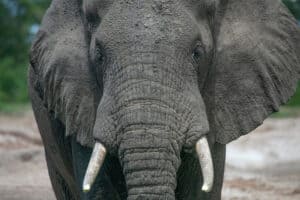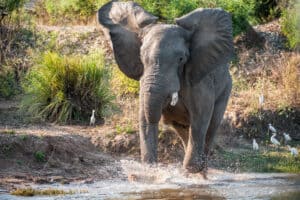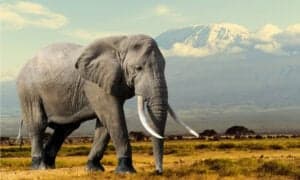- They nurse their young for 6 months.
- They also have hair on their heads and tails and are warmblooded.
From its long, flexible trunk to its loud trumpeting sounds, there’s a lot to admire about an elephant. But how much do you know about these massive creatures? Where do they live? How big can they get? Are elephants mammals?
Discover the answers to all of those questions along with a few more tidbits that will make you admire these animals even more.
Are Elephants Mammals?
The answer to this question is yes. In fact, elephants have the honor of being the biggest land mammal in the world.
There are two types of elephants: African and Asian. They both have long trunks, large ears, and sturdy bodies with light gray or dark gray skin. Besides the fact that African elephants live in Africa and Asian elephants live in Asia, there are some other differences between these two humongous creatures.
For one, male and female African elephants have tusks whereas only male Asian elephants can have tusks. Also, look at the head of each elephant and you’ll see an Asian elephant has two large bumps on its head while an African elephant has a rounded head.
An African elephant has bigger ears than an Asian elephant. Next time you visit a zoo, check out the ears of an African elephant. Their ears are shaped like the continent of Africa!
Another notable difference is African elephants are larger in size than Asian elephants. Male African elephants can weigh up to 13,300 pounds. Alternatively, male Asian elephants weigh up to 8,800 pounds.
An adult African bush elephant can be 13 feet tall. African bush elephants are the largest of the two African species. An adult Asian elephant grows to 9 feet in height. Though one species is taller than the other, both elephants view the world from a great height!
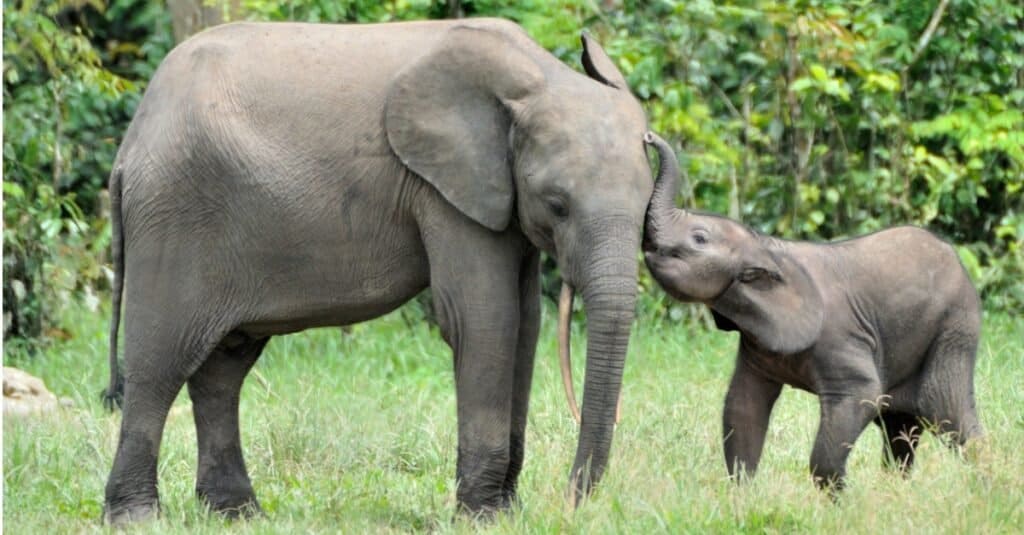
©iStock.com/USO
Elephants Give Live Birth to Their Young
After a 22-month gestation period, this mammal gives live birth to a single baby also known as a calf.
Other female elephants in the herd crowd around the female as a way to protect her while she gives birth. A female elephant remains standing during birth, so the calf drops to the ground when it’s born. Ouch! But, the calf is still inside the amniotic sac which gives it some cushion as it lands on the ground. The sac usually breaks open as the mother elephant starts to clean her newborn.
Elephant calves are just three feet in height and weigh around 250 pounds. The elephant calf is able to stand up only minutes after its birth. Standing up right away makes the calf a little less vulnerable to predators. In the first couple hours of life, the calf learns to walk and move around with its mother. This is essential to survival in its environment.
Elephants Nurse Their Young
Newborn and young mammals nurse from their mother. The calf will be encouraged to nurse by its mother and will get to tuck away copious amounts of milk – about 10 liters daily. The nourishment provided by the female elephant is rich in both fat and protein. (Elephant milk contains 100 times more protein compared to the more familiar cow’s milk.)
An elephant calf nurses its mother on and off throughout the day. In total, they nurse for around an hour each day. At approximately 6 months old, an elephant calf begins to sample vegetation and other food sources in the area alongside its mother. It may continue to nurse while completing the weaning process.
Elephants Are Warm-Blooded
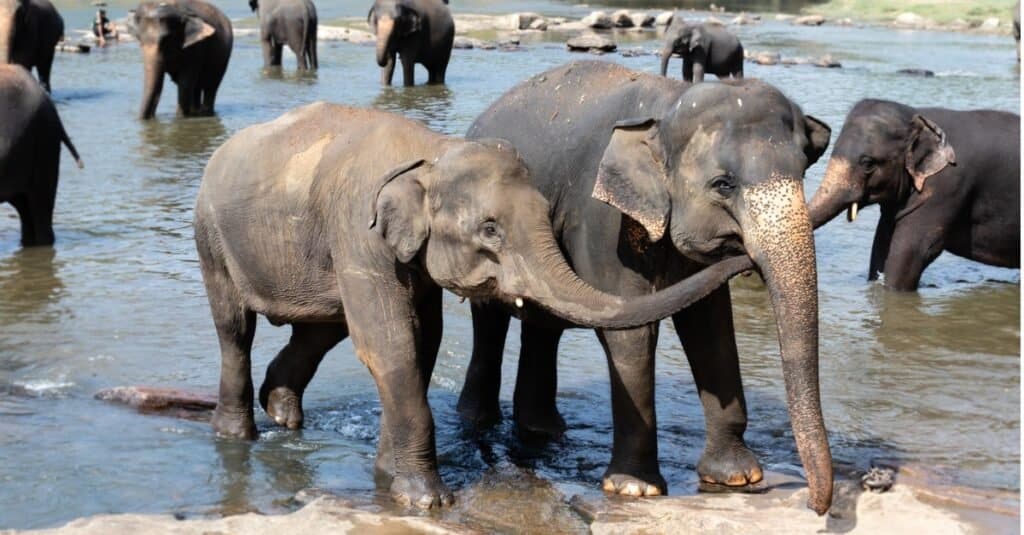
©iStock.com/Nilanka Sampath
Elephants, like other mammals, are warm-blooded. Being warm-blooded means this animal maintains a constant body temperature regardless of the temperature of the environment. Compare this to a reptile, like a black rat snake or a lizard. Reptiles are cold-blooded meaning their body temperature changes with the environment they live in. They aren’t able to maintain a warm body temperature like mammals.
Both Asian and African elephants live in habitats that can get very hot. So, these warm-blooded animals have to take steps to stay cool.
One thing elephants do to stay cool is flap their ears. An African elephant’s ears measure 6 feet in height with a width of 5 feet. So, you can imagine how much of a breeze they stir up by flapping their ears! Scientists took a closer look at the ear flapping process and found that the cool air is absorbed through the thin skin on their ears. This sends cooler blood moving into the rest of their body.
Another way these massive mammals keep cool is by taking a bath. They take in water from a pond or stream and squirt it with their trunk onto their back. As the water evaporates it cools their skin.
One misconception about elephants is they drink water through their trunk like you would sip juice through a drinking straw. Elephants drink water via their mouth, but they can use their trunk to suck some of the water from their mouth in order to squirt it.
Have you ever seen a video of an elephant kicking clouds of dust up around its body? If so, you’ve observed another way that an elephant cools down in hot temperatures. The dust settles on the elephant’s skin helping to reflect the harsh sunlight. Pretty smart, right?
Elephants Have Hair
Growing hair is another characteristic of a mammal. Do elephants have hair?! Yes, they do! They have bristly hair on their heads and tails. Of course, elephants don’t have a full coat of hair like a grizzly bear or muskox. Like those other mammals, the amount of hair an elephant has helps it to survive in its particular environment.
Up Next…
Keep reading these posts for more incredible information about key animal facts.
- What Do Elephants Eat? Their Diet Explained: Just how much are they capable of putting away? Do they have a sweet tooth? Click on the link to find out.
- Elephant Lifespan: How Long Do Elephants Live? How many years can they expect to live and does it depend on what species they are? All the answers to your questions can be found right here.
- Types of Elephants: The 3 Species of Elephants: Even though they might look the same they’re actually different species. And they’re all covered here.
The photo featured at the top of this post is © iStock.com/AndreAnita
FAQs (Frequently Asked Questions)
How many species of elephant are there?
There are 3 species of elephants. Those are the African bush elephant, the African forest elephant, and the Asian elephant.
Are elephants endangered?
Unfortunately, the answer is yes. The Asian elephant is listed by the IUCN Red List of Threatened Species as Endangered. Habitat loss and poaching activity by humans both factor into the drop in their population.
The African bush, or savanna, the elephant is considered Endangered as well. The decrease in population is a result of poaching. These elephants are hunted for their tusks.
The African forest elephant is Critically Endangered. Their population is dropping in number because they are poached by humans for their ivory tusks.
How long do elephants live?
Elephants have a long lifespan. African elephants can live 60 to 70 years. Asian elephants live up to 48 years.
Are elephants solitary?
No, but some elephants live in larger groups or herds. Males tend to live with a few other male elephants. Females form large herds with other females along with their young calves. Though the male herds are smaller they usually live in the vicinity of the large herds of females.
Are elephants shy or aggressive?
Normally, elephants are peaceful mammals. They spend their days eating roots, leaves, bark, and other vegetation in their habitat. But, if a female with a calf or a herd of females with calves feel their young are being threatened, they become aggressive.
As a note, the size of a healthy adult elephant discourages most animal predators from attacking it. A predator or pair of predators may try to attack an adult elephant that is elderly or is suffering from an illness. Elephant calves are especially vulnerable to predators like hyenas, crocodiles, and lions.
A herd of female elephants may charge toward a predator and trample it to death to keep it from attacking a calf in the herd.
Thank you for reading! Have some feedback for us? Contact the AZ Animals editorial team.



